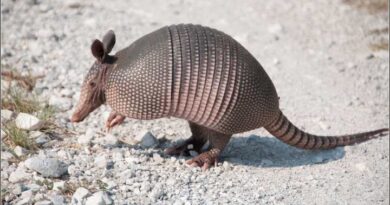Cross Fox
The cross fox is a fascinating variant of the red fox (Vulpes vulpes), known for its partially melanistic appearance. Its most distinct feature is the long dark stripe that runs down its back, intersecting another stripe over the shoulders, forming a unique cross. While the cross fox is rarer than the common red form, it is still more common than the darker silver fox. These foxes tend to be more abundant in the northern regions of Canada and can also be spotted in northern Minnesota, particularly around the North Shore. Despite being a small wild dog, the cross fox thrives in both wild and populated areas, making it a unique sight to see.
A Once Misunderstood Species
At one time, the cross fox was considered a separate species from the red fox, even given the binomial name Canis decassatus. However, modern scientists have concluded that the cross fox is simply a melanistic color variant of the common red fox (Vulpes vulpes). Despite this, fur farmers and trappers continued to treat each colour form as distinct for a long time. The confusion likely stemmed from the cross fox’s striking appearance, with its long dark stripe that runs down its back and intersects with another stripe over the shoulders, forming a cross-like shape.
The fox genus, Vulpes, includes several species that are part of the family Canidae, and the red fox is one of the most widespread. These foxes are found in Europe, temperate Asia, northern Africa, and North America. With the largest natural distribution of any land mammal besides humans, the red fox has even been introduced to Australia in the 19th century, where it established itself across much of the continent. The cross fox shares this wide range of habitats, from mixed landscapes of forests and grasslands to more extreme environments like Arctic tundra and arid deserts.
This unique fox has long been a symbol of cunning in folklore, often hunted for sport or raised commercially for their valuable pelts. The black fur on the face, neck, and chest of the cross fox gives it the appearance of wearing a mask, setting it apart from its muddy red fox relatives. While not a different species, the cross fox has always held a special place in both culture and nature due to its striking look and adaptability.
A Common Sight in Northern Areas
Cross foxes are relatively common in the northern areas of North America, especially in Canada, where they can make up to 30% of the red fox population. Although their numbers are smaller compared to the reddish form, they are still abundant in places like Idaho and Utah. However, in some areas, they have been largely killed off. Cross foxes have also been occasionally reported in Scandinavia, where early naturalists like Conrad Gessner and Olaus Magnus first described them.
A study based on nearly 3,000 skins revealed that 99% of the red foxes had the familiar reddish coat, with the cross fox accounting for just 0.3% of the remaining 1%. These cross foxes have a yellowish-brown coat with a distinctive black cross that extends from their shoulders down their back, setting them apart from the common red and silver varieties. Though sightings of cross foxes are relatively uncommon, especially in the United States, they are most frequently observed in the northern parts of Minnesota and along the US/Canadian border.
In terms of size, diet, and behavior, cross foxes are similar to the common red fox, measuring between 90–105 cm (36–42 inches) in length and weighing around 5–7 kg (10–15 pounds). Their rich reddish-brown coat, combined with black ears and legs, along with white-tipped tails, make them a stunning yet rare sight, especially in North America. Though their darker color variant makes them stand out, they share many traits with other wild dogs, like the grey wolf, making each encounter with them an exciting experience for observers.
Predators and Prey
Cross foxes, like red foxes, thrive in various environments, from patches of forests and grasslands to more extreme areas like the Arctic tundra and arid deserts. Their preferred habitat includes mixed landscapes with a combination of land-use types, allowing them to adapt to human presence. They have become common in farmland, woods, and even urban ecosystems. In large cities and suburbs, they are known to forage for food, including mice, voles, rabbits, eggs, and fruit. They readily consume whatever is available, including garbage, carrion, and pet food left unattended overnight.
Historically, wolves and other large predators kept red fox populations in check through aggressive behaviour and territoriality. But in the middle of the 20th century, many of these larger predators were removed by humans, especially in urban areas and agricultural regions across Europe and North America. This led to the rise of medium-sized predators or mesopredators like coyotes and raccoons, which now compete with cross foxes for resources. While they forage and hunt smaller prey, they also live in fear of encountering these larger competitors, which adds substantial hunting pressure to their lives.
When it comes to their diet, cross foxes, much like red foxes, are opportunistic feeders. They will hunt small animals like birds, and it’s estimated that red foxes alone can kill over one million wild ducks each year in the prairies of North America. However, their impact extends beyond the wild, as they also affect domestic birds and wild game birds. In areas where birds are bred for hunting or food, such as game farms and bird-production areas, fox populations are often regulated to prevent overhunting.
Interestingly, urban cross foxes have shown unique behavioral adaptations compared to their rural counterparts. They tend to be more nocturnal and even display more aggressive behaviors due to the dense competition in human-dominated environments. Some biologists have observed that urban foxes have developed shorter, wider snouts and smaller braincases, possibly as an adaptation to life in urban ecosystems. These changes highlight their incredible ability to adapt and survive in both wild and urban conditions.
Breeding Habits
Like red foxes, cross foxes mate in the winter, with a gestation period of about seven to eight weeks. The female, or vixen, gives birth to 1–10 young, with an average of 5 kits. The birth typically happens in a den or burrow, often one that’s been abandoned by another animal and enlarged by the parent foxes. Both parents care for the cubs throughout the summer, and by the fall, the young are fully grown and become independent.
Physical Traits
In terms of physical conformation, cross foxes are nearly identical to red foxes, though they may be slightly larger with a bushier tail and more wool under their feet. According to Teancum’s Mammals of Utah (1922), they derive their name from the vertical dark band running down the back, which is intersected by a horizontal stripe across the shoulders. The fur on their flanks, neck, and sides is a mix of yellowish rufous and vivid red, with the hindquarters and outer thighs taking on a dusky brown color. The black outer fur of the tail has long hairs that can appear greyish or yellowish red, with tips that are sometimes white.
These melanistic foxes are often spotted in areas like the North Shore and along the US/Canadian border, especially near Grand Portage and Grand Marais. While sightings can be a challenge, keeping your eyes peeled on the Gunflint Trail or around Highway 61 might reward you with a glimpse of these beautiful creatures. Though they share many traits with the common red fox, their unique coloring and dorsal stripe make them a rare and exciting find.
Their Historic Value in Fur Trade
Cross foxes were historically hunted and even bred for their valuable fur, especially their silver coats, which were seen as prestigious. These pelts were often used to adorn leaders and certain religious communities. In the late 19th century, the Hudson’s Bay Company exported around 4,500 pelts annually, and about 3,500 skins were sold at auction in London. The value of a cross fox’s pelt depended on its darkness, with pale coats fetching lower prices. Darker pelts were more expensive, though still not as valuable as red fox pelts, which were worth about 4–5 guineas per skin, compared to the common variety’s price of 15 shillings.



